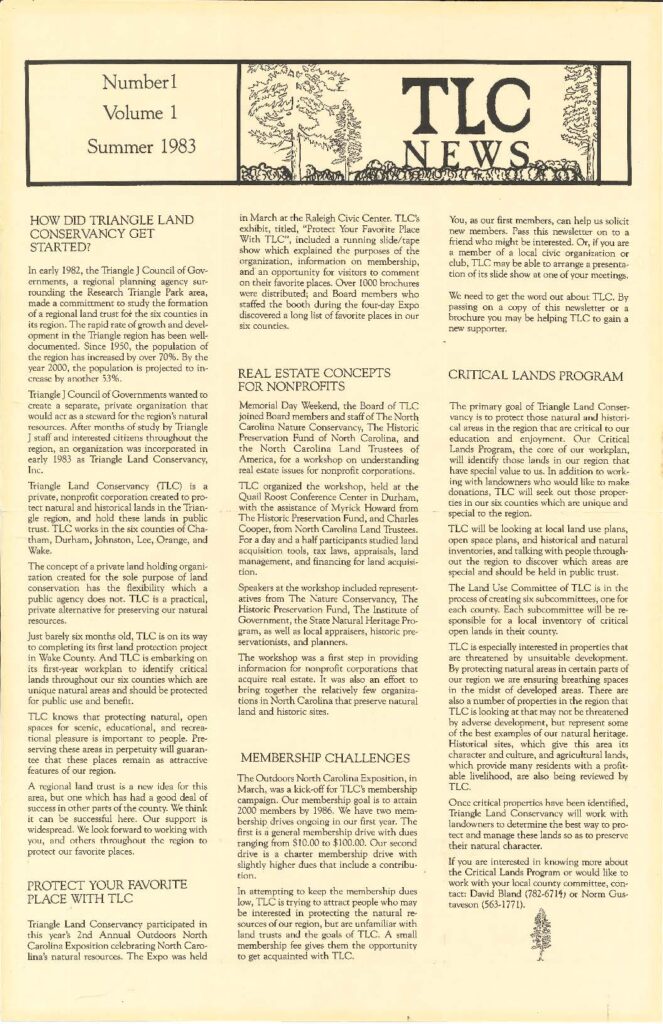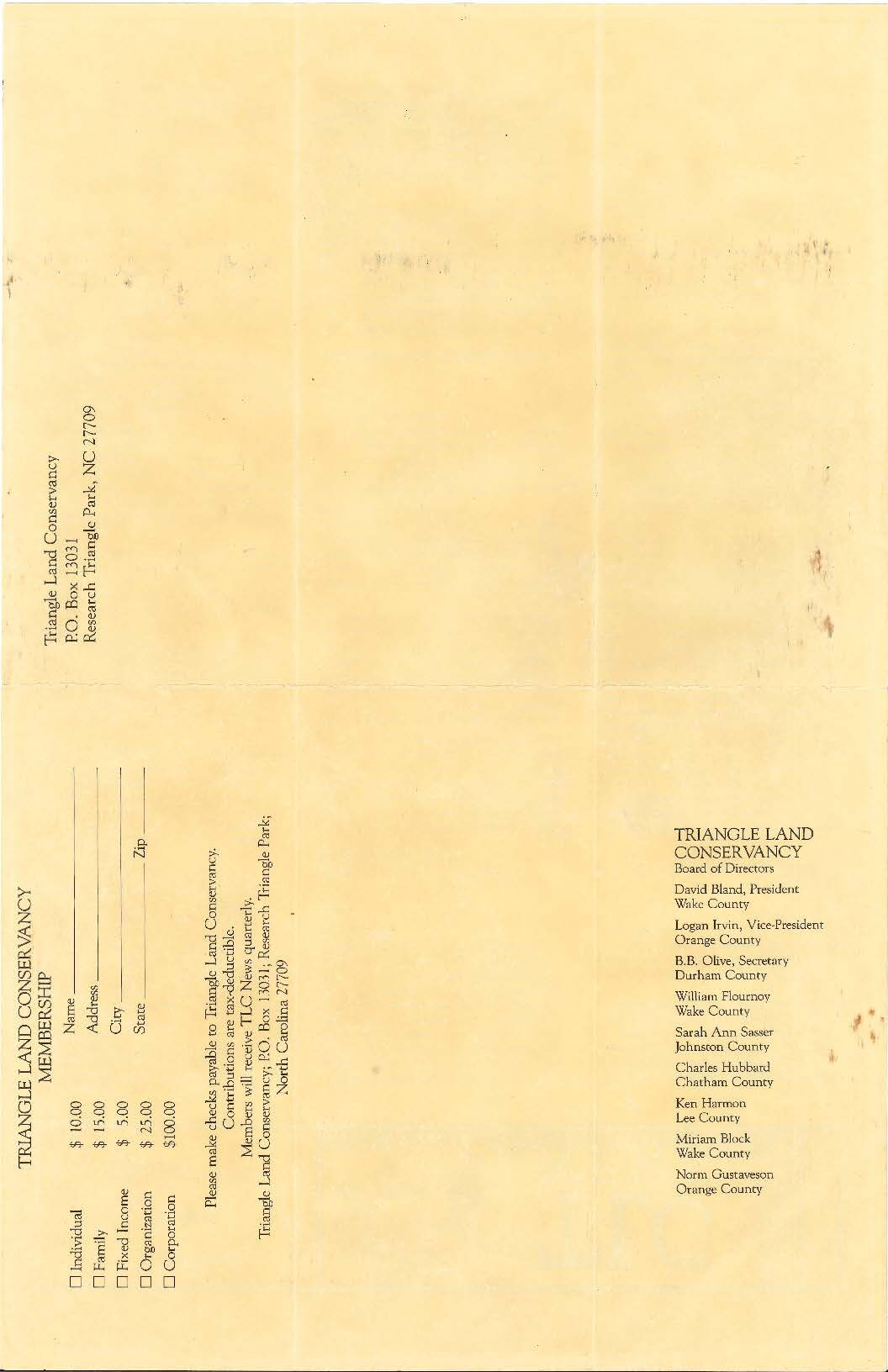Written in Summer 1983, TLC’s first newsletter “TLC News” introduces the Triangle community to the concept of a regional land trust. TLC’s collaborative efforts culminated in 1984 with our first conserved property, Temple Flat Rock in Wake County. Since then, with the help of dedicated supporters, we have conserved over 23,000 acres of vital watersheds, farmlands, and natural habitats and opened 8 public nature preserves across the 6 counties of the Triangle region. Read along to learn more about how TLC founders worked to identify critical lands for conservation, engaged a brand-new membership base, and began a legacy of striving for a healthier and more vibrant Triangle.

“In early 1982, the Triangle J Council of Governments, a regional planning agency surrounding the Research Triangle Park area, made a commitment to study the formation of a regional land trust for the six counties in its region. The rapid rate of growth and development in the Triangle region has been well documented. Since 1950, the population of the region has increased by over 70%. By the year 2000, the population is projected to increase by another 53%.
Triangle J Council of Governments wanted to create a separate, private organization that would act as a steward for the region’s natural resources. After months of study by Triangle J staff and interested citizens, throughout the region, an organization was incorporated in early 1983 as Triangle Land Conservancy, Inc.
Triangle Land Conservancy (TLC) is a private, nonprofit corporation created to protect natural and historical lands in the Triangle region, and hold these lands in public trust. TLC works in the six counties of Chatham, Durham, Johnston, Lee, Orange, and Wake.
The concept of a private land holding organization created for the sole purpose of land conservation has the flexibility which a public agency does not. TLC is a practical, private alternative for preserving our natural resources.
Just barely six months old, TLC is on its way to completing its first land protection project in Wake County. And TLC is embarking on its first-year workplan to identify critical lands throughout our six counties which are unique natural areas and should be protected for public use and benefit.
TLC knows that protecting natural, open spaces for scenic, educational, and recreational pleasure is important to people. Preserving these areas in perpetuity will guarantee that these places remain as attractive features of our region.
A regional land trust is a new idea for this area, but one which has had a good deal of success in other parts of the country. We think it can be successful here. Our support is widespread. We look forward to working with you, and others throughout the region to protect our favorite places.

Protect Your Favorite Place With TLC
Triangle Land Conservancy participated in this year’s 2nd Annual Outdoors North Carolina Exposition celebrating North Carolina’s natural resources. The Expo was held in March at the Raleigh Civic Center. TLC’s exhibit, titled, “Protect Your Favorite Place With TLC,” included a running slide/tape show which explained the purposes of the organization, information on membership, and an opportunity for visitors to comment on their favorite places. Over 1000 brochures were distributed; and Board members who staffed the booth during the four-day Expo discovered a long list of favorite places in our six counties.
Real Estate Concepts For Nonprofits
Memorial Day Weekend, the Board of TLC joined Board members and staff of The North Carolina Nature Conservancy, The Historic Preservation Fund of North Carolina, and the North Carolina Land Trustees of America, for a workshop on understanding real estate issues for nonprofit corporations.
TLC organized the workshop, held at the Quail Roost Conference Center in Durham, with the assistance of Myrick Howard from the Historic Preservation Fund, and Charles Cooper, from North Carolina Land Trustees. For a day and a half participants studied land acquisition tools, tax laws, appraisals, land management and financing for land acquisition.
Speakers at the workshop included representatives from The Nature Conservancy, The Historic Preservation Fund, The Institute of Government, the State Natural Heritage Program, as well as local appraisers, historic preservationists, and planners.
The workshop was a first step in providing information for nonprofit corporations that acquire real estate. It was also an effort to bring together the relatively few organizations in North Carolina that preserve natural land and historic sites.
Membership Challenges
The Outdoors North Carolina Exposition, in March, was a kick-off for TLC’s membership campaign. Our membership goal is to attain 2000 members by 1986. We have two membership drives ongoing in our first year. The first is a general membership drive with dues ranging from $10.00 to $100.00. Our second drive is a charter membership drive with slightly higher dues that include a contribution.
In attempting to keep the membership dues low, TLC is trying to attract people who may be interested in protecting the natural resources of our region, but are unfamiliar with land trusts and the goals of TLC. A small membership fee gives them the opportunity to get acquainted with TLC.
You, as our first members, can help us solicit new members. Pass this newsletter on to a friend who might be interested. Or, if you are a member of a local civic organization or club, TLC may be able to arrange a presentation of its slide show at one of your meetings.
We need to get the word out about TLC. By passing on a copy of this newsletter or a brochure you may be helping TLC to gain a new supporter.

Critical Lands Program
The primary goal of Triangle Land Conservancy is to protect those natural and historical areas in the region that are critical to our education and enjoyment. Our Critical Lands Program, the core of our workplan, will identify those lands in our region that have special value to us. In addition to working with landowners who would like to make donations, TLC will seek out those properties in our six counties which are unique and special to the region.
TLC will be looking at local land use plans, open space plans, and historical and natural inventories, and talking with people throughout the region to discover which areas are special and should be held in public trust.
The Land Use Committee of TLC is in the process of creating six subcommittees, one for each county. Each subcommittee will be responsible for a local inventory of critical open lands in their county.
TLC is especially interested in properties that are threatened by unsuitable development. By protecting natural areas in certain parts of our region we are ensuring breathing spaces in the midst of developed areas. There are also a number of properties in the region that TLC is looking at that may not be threatened by adverse development but represent some of the best examples of our natural heritage. Historical sites, which give this area character and culture, and agricultural lands, which provide many residents with a profitable livelihood, are also being reviewed by TLC.
Once critical properties have been identified, Triangle Land Conservancy will work with landowners to determine the best way to protect and manage these lands so as to preserve their natural character.”


